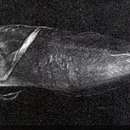Diagnostic Description
(
Inglês
)
fornecido por Fishbase
Diagnosis: Dorsal fin XII-XIII (usually XII), 13-16, dorsal membrane attached to caudal fin, with distinct notch above last spine, first spine almost equal higher than second; most spines filamentous; anal fin II, 14-17; pectoral rays 15; pelvic fin I, 3-4; caudal fin procurrent rays 8-14. Vertebrae 10 (rarely 11) + 19-21(usually 20); last pleural rib on 11th vertebral centrum, last epipleural rib on 13-17th. Body depth at anal-fin origin 3.6-3.8 in SL. LL, without scales and scalelike flaps; LL tubes 0-5 (rarely up to 8), canal ends below 12th dorsal spine to 11th dorsal ray. Lower lip smooth mesially, plicate laterally. Upper lip crenulae 26-50. Gill rakers 21-27. Cephalic sensory pore system simple. Cirri: supraorbital 4-13 (usually 4-10); nasal 4-34 (usually 6-14); nuchal 22-39 (usually 25-31), in 4 groups, dorsalmost groups sometimes unconnected at their bases, slightly expanded nuchal flap at bases of ventralmost cirri, 2 pores behind nuchal flap. This species of the genus shows the greatest variation and does not have strong modes for meristic characters. Geographic variation for characters midsnout pores and pelvic fin rays; those with 4 pelvic rays have midsnout pores, but it may be present or absent in those with 3 pelvic rays; in some localities both population types are common. Over all brown, with red spots on cheeks and snout but none on body; inner ring of iris yellow, outer red; eyes with yellowish-brown bars beneath; pectoral fins yellowish; caudal fin proximal half brown, distal half with yellow upper rays and reddish lower rays (Ref. 529, 90102). Ophioblennius stage 2.0 cm in SL; overall cream including cirri; no distinct spots (Ref. 529).
- licença
- cc-by-nc
- direitos autorais
- FishBase
- Recorder
- Estelita Emily Capuli
Life Cycle
(
Inglês
)
fornecido por Fishbase
Oviparous, distinct pairing (Ref. 205). Urogenital orifice of male genital papilla located basally between 2 closely appressed, small, slender filaments on a fleshy swelling behind anus; testes bulbous with length equal to its width (Ref. 529).
- licença
- cc-by-nc
- direitos autorais
- FishBase
- Recorder
- Estelita Emily Capuli
Morphology
(
Inglês
)
fornecido por Fishbase
Dorsal spines (total): 11 - 13; Dorsal soft rays (total): 13 - 16; Analspines: 2; Analsoft rays: 14 - 17; Vertebrae: 29 - 31
- licença
- cc-by-nc
- direitos autorais
- FishBase
- Recorder
- Estelita Emily Capuli
Trophic Strategy
(
Inglês
)
fornecido por Fishbase
This species can tolerate a wider range of environmental conditions than others of this genus. Usually found on coral or rocky reefs to 20 m deep (Ref. 529). Found solitary or in small groups (Ref. 90102).
- licença
- cc-by-nc
- direitos autorais
- FishBase
- Recorder
- Grace Tolentino Pablico
Biology
(
Inglês
)
fornecido por Fishbase
This species can tolerate a wider range of environmental conditions than others of this genus. Adults usually are found on coral or rocky reefs to 20 m deep (Ref. 529). Found solitary or in small groups (Ref. 90102). Oviparous. Eggs are demersal and adhesive (Ref. 205), and are attached to the substrate via a filamentous, adhesive pad or pedestal (Ref. 94114). Larvae are planktonic, often found in shallow, coastal waters (Ref. 94114).
- licença
- cc-by-nc
- direitos autorais
- FishBase
- Recorder
- Estelita Emily Capuli
Importance
(
Inglês
)
fornecido por Fishbase
fisheries: of no interest; aquarium: commercial
- licença
- cc-by-nc
- direitos autorais
- FishBase
- Recorder
- Estelita Emily Capuli

